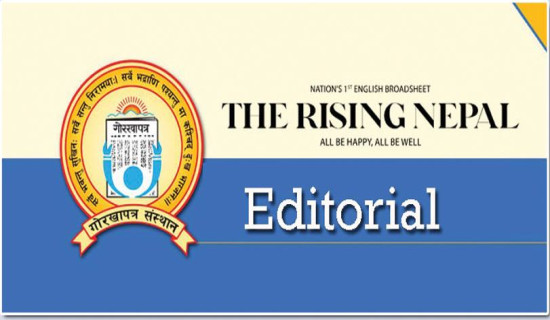- Tuesday, 16 December 2025
Flexible, Growth-oriented Monetary Policy
The monetary policy for the fiscal year 2025/26, which was unveiled by Nepal Rastra Bank (NRB) on July 11, 2025, aims to boost the sluggish economy by improving various sectors such as the financial sector and the share market. Although the cash reserve ratio and the statutory liquidity ratio have been left unchanged, the interest corridor has been modified by retrenching the bank rate, the upper limit, to 6 per cent from 6.5 per cent and the deposit collection rate, the lowest limit, to 2.75 per cent from 3 per cent. Likewise, the policy rate has been reduced to 4.5 per cent from 5 per cent. This provision is aimed at increasing lending by decreasing rates on lending and deposits. Deposit-holders will, however, be affected by this provision. The monetary policy aims at expanding lending to the private sector to 12 per cent.
Another provision of credit expansion is increasing the limit on residential home loans and margin lending. As per the new provisions, the limit on residential home loans has been increased to Rs. 30 million from Rs. 20 million with a loan-to-value ratio of 80 per cent, up from 70 per cent. Likewise, an individual can avail themselves of up to Rs. 250 million as a margin loan, up from Rs. 150 million. Such provisions will help boost the home loan sector and the share market, both of which are sluggish now. Registered businesses along mid-hill and postal highways will be promoted through concessional lending under prescribed standards.
Rescheduling of loans
The restructuring and rescheduling of loans disbursed to registered land development and building construction companies/firms will be facilitated. The real estate sector has been stagnant for the last three or four years. Real estate entrepreneurs are finding it hard to repay their loans. On the other hand, banks have been forced to treat such loans as bad loans. The provision will give respite to both real estate entrepreneurs and banks. The existing loan classification and loan loss provision will be reviewed as required. It is expected that such provisions will be revised, keeping abreast of the changing times and according to international best practices, resulting in increased profits for banks.
The provision of interest on the loans disbursed in the energy sector will be reviewed. This will facilitate interest capitalisation, allowing interest earned during the construction phase to be capitalised, which will make it easy for energy entrepreneurs to repay loans. The provision of treating loans up to Rs. 30 million as small and medium enterprise (SME) loans and including them in priority-sector loans is beneficial for banks. This will encourage small-scale lending at a cheaper rate of interest. Priority-sector lending attracts a lower rate of interest. Loans of up to Rs. 300,000 (or Rs. 500,000 for women) disbursed to people going abroad for foreign employment will be included in deprived-sector lending, which will help banks fulfil their deprived-sector lending target.
The branch expansion policy will be reviewed in view of the flourishing electronic payment system. The branches of commercial banks have covered all the local levels of the country. The number of such branches is more than enough in urban areas. Such branches can be reduced by merging them. On the other hand, new branches can be established in remote areas where there are no branches. Revising the branch expansion policy along these lines will reduce the operational cost of banks and give relief to the people deprived of banking services.
The monetary policy has paid adequate heed to promoting foreign direct investments. For this, foreign companies operating in the country, companies established with foreign direct investments and branches of foreign companies will be permitted to repatriate profits, interest and dividends to their countries in a hassle-free manner. Foreign exchange risk management will be undertaken through banks. Such a provision is expected to attract more foreign direct investments. The provision allowing microfinance companies to mobilise deposits up to 15 times their core capital has been done away with. This will enable the class ‘D’ financial institutions to increase their deposits and boost their lending capacity. In a similar vein, the ceiling on the bonus distribution, not more than 15 per cent of finance companies, has been removed.
Expanding transactions
With this provision, the class ‘C’ financial institutions will be encouraged to make more profits by expanding their transactions. This will also enhance their performance in the share market. Non-performing loans (NPLs) and non-banking assets (NBAs) have become a headache for banks. Measures have been mentioned in the monetary policy to address these issues. Accordingly, initiatives will be made by the NRB to establish an Asset Management Company. NPLs and NBAs are being managed by banks themselves due to a lack of a relevant company. Further, regulatory reserves generated from non-banking assets held for two years will be allowed to be included in the supplementary capital. This will release some funds for banks for lending.
A provision has been made for classifying remittance companies based on their capital and transactions in view of the burgeoning remittance business. Remittance companies have objected to this provision, arguing that small remittance companies, which may be categorised as ‘B’, ‘C’ or ‘D’ companies, may have difficulty competing with top remittance companies. Now, there is no difference in the nature of transactions being conducted by top or other remittance companies. It is feared that the remittance transactions being conducted by them may shift to banks as well. In a nutshell, the newly unveiled monetary policy is flexible and has made provisions to boost the banking sector and the national economy to help achieve the 6 per cent economic growth target as mentioned in the budget for the fiscal year 2025/26.
(Maharjan has been regularly writing on contemporary issues for this daily since 2000.)

















